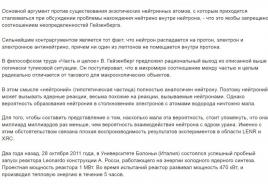The largest literary work. Longest novel
Not all writers agree with the statement "Brevity is the sister of talent." In today's selection, we offer longest novels in literary history... The authors spent years creating them. But reading them will take a lot of time.
By the way, the novel "War and Peace" by Leo Tolstoy hit the top ten, so every Russian schoolchild can proudly declare that he is familiar with one of the most long books firsthand.
10. "Tokugawa Ieyasu", S. Yamaoka
This novel was published in parts in Japanese newspapers. If you collect all the parts into a single work, then you get at least 40 volumes. The plot of the novel is dedicated to the first shogun of the Tokugawa clan, who united the country and established peace in it.
9. "Quiet Don", M. Sholokhov
All four books that make up the novel are about 1,500 pages long. There are 982 heroes in the novel, of which 363 are real historical characters. For "Quiet Don" Sholokhov was awarded the Nobel Prize with Stalin's consent.
8. "Les Miserables", V. Hugo
One of his main works, Hugo created for eighteen years - from 1834 to 1852. Then the author revised the text several times, adding and removing various fragments.
7. "In Search of Lost Time", M. Proust
This is a whole cycle of 7 novels, in which there are more than two thousand characters. The books are replete with emotional outbursts, bizarre narrative twists. In total, "In Search of Lost Time" has more than one and a half million words, which occupy about 3,200 pages.
6. "The Forsyte Saga" by D. Galsworthy
Novel nobel laureate strikes with clearly defined images of heroes. The work covers the history of the family from the 1680s to the 1930s. "Saga" formed the basis for 6 film adaptations, the most recent of which has a duration of 11.5 hours.
5. "War and Peace", L. Tolstoy
Everyone who has read War and Peace can be divided into two categories. Some of the novel are completely delighted, others - can not stand it. But the epoch-making work in three volumes does not leave anyone indifferent.
4. "Quincunx", C. Palliser
This work is a modern stylization of the Victorian novel. Each of the two volumes has a volume of 800 pages, depending on the edition. The plot is full of mysteries, symbolism and unexpected twists and turns.
3. "Ulysses", J. Joy
The novel is considered one of the best works of English-language prose. "Ulysses" was written over seven long years, while it tells the story of one day of the Dublin Jew Leopold Bloom. The novel was first published in parts from 1918 to 1920.
2. "Astrea", O. d'Urfe
The novel was written in 21 years of hard work. The work in the first edition fit into 5 399 pages. Published in 1607, the novel tells about the love between the shepherd Astrea and the shepherd Celadon. The book contains a lot of inserted short stories and poetic inclusions.
1. "People of Good Will", R. Jules
The novel by the French playwright, writer and poet was published in 27 volumes. The work has over two million words on 4,959 pages. The table of contents for the longest novel in the world is about 50 pages. It is noteworthy that the book does not have a single and clear storyline, and the number of characters exceeds four hundred.
There are many records set by books. Known for the thickest and longest books, the books with the highest circulation and the largest books in the world. Some of them are originally published with the aim of becoming very-very.
Longest books
Speaking about the longest books, you can mean the length of the book by its duration, or you can mean its actual (physical) length.It should be noted that it is difficult to imagine a person who would devote years of his life to the creation of an actually long book. Usually writers strive to convey the meaning of their work, even the longest of all, through the depth of words and thoughts.
"People of goodwill"
For fourteen years, starting in 1932, Jules Romain wrote a novel called People of Good Will. It contains at least two million words. The novel was published in twenty seven volumes. It is recognized as the longest in the world. The table of contents, which takes as many as fifty pages, evokes a very mixed reaction. 
The novel contains spirituality, crime, poverty, wealth, culture and politics. In twenty-seven volumes, the author described the life of four hundred heroes, touching upon the events from 1908 to 1933. Unfortunately, the literary world did not accept this work quite the way the author wanted it. After the publication of the novel, it was heavily criticized. The idea was expressed that the author distorted the events of that time, misunderstanding the history.
"Fantastic"
The length of the book with the title “Fantastic” is one kilometer, eight hundred and fifty-six meters. This is the longest (physically) book in the world. It was created by four hundred people from the educational city of Castello. The teachers of the center and even the families of all participants also participated in this "experiment". 
The book was made of papyrus and wound on a pole. The record was registered by one of the notaries of the city of Castello. It includes eleven fairy tales, the main idea which is poverty and wealth.
The thickest books
There are several record-breaking thick books. One of them is "WIKIPEDIA", which is an article from the Internet, collected in one printed edition. There is an assumption that this collection of articles was published only for the book of five thousand pages to get into the Guinness Book of Records. It is doubtful that such a thick book can be read - it is completely impractical to use it. 
Another record-breaking book is the world's thickest edition about Miss Marple, printed as a complete essay. The works of Agatha Christie, collected in one book, fit on four thousand thirty-two pages. The spine of this edition is three hundred twenty-two millimeters wide and weighs eight kilograms. Despite the fact that such a giant book is most likely unsuitable for reading, it was published in the amount of five hundred copies.
Books with the largest circulation
No wonder the Bible is called a book-books. It has been reprinted many times in all countries of our planet. Its popularity not only does not fall, but continues to rise. To date, the number of copies of this book published is approximately six billion. 
Another book, the circulation of which can be safely called one of the largest, is the quotation book by Mao Zedong. Its circulation is one billion copies. Usually this book is published with a red cover, for which in Western countries the quotation book is often called the "Red Book".
John Tolkien's fantasy book The Lord of the Rings, which is in third place, lags far behind in terms of circulation. Its circulation is one hundred million copies. Approximately the same circulation for the book called "American Spelling Guide" and the "Guinness Book of Records", which are in the fourth and fifth places in the ranking of books with the largest circulation.

Sixth in the ranking is the World Yearbook with a circulation of eighty million copies, and seventh place is the McGuffey Children's Reading Anthology. The circulation of this book is sixty million copies. With a circulation of fifty million copies, the book "The Basics of Child Care" was published. "The Da Vinci Code" took the ninth line of the rating with a circulation of forty-three million, and in the tenth place of honor, the work of Elbert Hubbard with a circulation of forty million. Its name is "Message to Garcia".
The largest book in the world
According to the Guinness Book of Records, the world's largest printed book is The Giant Visual Odyssey of the Kingdom of Bhutan. The dimensions of its pages are one hundred fifty-two by two hundred and thirteen centimeters. The total weight of this book, consisting of one hundred and twelve pages, is almost sixty kilograms. Today only eleven copies have been created. 
To print one book, you need to spend a roll of paper, the length of which is comparable to the length of a football field. The technology for printing this book was invented and developed by Michael Hawley, a researcher at the Massachusetts Institute. Anyone can order the book for thirty thousand dollars.

It is known about "Superbook", which was published in 1976 in Denver. Its dimensions are three hundred seven by two hundred and seventy-four centimeters and weighs almost two hundred fifty-three kilograms. In 2004, the publishing house "In" set a new record in Russia, namely, the book "The Biggest Book for Kids" was published. Its dimensions are capable of striking everyone - six by three meters and weighs four hundred ninety two kilograms. It is difficult to imagine such a book, because the area of \u200b\u200beach page is equal, no less than eighteen square meters.

There are other amazing books as well. For example, the most expensive volume of poetry was the publication of Poe's book "Tamerlane and Other Poems". ...
Subscribe to our channel in Yandex.Zen
The mention of L. Tolstoy's novel "War and Peace" somehow immediately prompted memories of his reading in school years... Few have mastered this work, grandiose in its scope and design. It seemed to many that four volumes were simply overwhelming. Naturally, I wanted to look if there are works of greater volume, so to speak. And, of course, there were some.
The novel Tokugawa Ieyasu by Japanese chronicler Sohachi Yamaoka has been published in parts in Japanese daily newspapers since 1951. Today the novel "Tokugawa Ieyasu" is completed, and if it is republished in full, it will be a 40-volume edition. It is not known if this will ever happen, but the fact remains! The novel tells about the adventures of the first shogun of the Tokugawa clan, who unified Japan and established peace in the country for many years.
The longest work in the history of literature is considered the novel "People of Good Will" by a French writer, poet and playwright, a member of French academy Romain Jules (real name - Louis Henri Jean Farigoul). People of Goodwill is a complete publication that can be purchased and read sequentially. It was published in twenty seven volumes from 1932 to 1946. It is estimated that the novel was 4,959 pages long and contained approximately 2,070,000 words (excluding the 100-page index and 50-page table of contents). For comparison, the Bible has about 773,700 words.

In the novel People of Goodwill, Jules tried to understand and explain the historical processes that took place in France in the thirties from the point of view of his right-wing views. An essay in prose was supposed to express in all its diversity and in the smallest detail the picture of the contemporary world to the author.
The book does not have a clear plot, and the number of heroes exceeds four hundred. “People of good will! Under the sign of an ancient blessing, we will seek them in the crowd and gain them. ... let them find some sure way to recognize each other in the crowd, so that this world, whose honor and salt they are, does not perish. "
In the foreword to his long-term creative marathon, the author questioned the structure of writing Balzac's masterpieces such as Proust and Roland. Because he considered unacceptable the “mechanistic” idea of \u200b\u200bwriting multivolume novels, where the whole is revealed through a single personality. That is, Jules Romain himself, publishing his first volume back in 1932, was confident in the idea of \u200b\u200bthe confusion and disorder of the plot and the life of all its heroes (and as already mentioned, there were about 400 of them in People of Goodwill).
The longest book really has it all: criminality and spirituality, wealth and poverty, politics and culture. And, of course, all events are supported by the ideas of the history of that time. In general, the novel told about the events of 1908-1933. The author of this work rather tried to help understand all the vicissitudes of the time of crisis that the French people faced. However, Jules Romain did not shy away from writing articles and essays on various scientific, political and literary topics - he was known as an erudite person.
However, the novel itself was subsequently heavily criticized. The literary world did not accept the work the way the creator wanted it. The prosecution prescribed a distorted statement of fact to this work. Jules Romain has been criticized for misunderstanding history. Therefore, if you are ready to justify a writer, even in the 21st century, then start reading the longest book in the world.
Here are the top 12 longest works in literary history that prove that not everyone catch phrase you have to believe blindly.
James Joyce (1882-1941)
Ulysses (1922)
The main character - Leopold Bloom, Dublin Jew. The day is filled with events - Bloom has time to attend a funeral, on the shore of the bay, in a maternity hospital, in a brothel and in several other places between times. The plot of the novel revolves around the infidelity of Bloom's wife. However, this work cannot be described so flatly and everyday.
In the semantic depths of "Ulysses" one can see analogies and allusions to many works and heroes of world literature, to the archetypes of the female and male principles, and relations between generations. The clearest, of course, is the reference to Homer's Odyssey, which Joyce considered one of the most universal myths
 |
1926 |
The novel does not have a single style - the author parodies or imitates different styles and different authors, as if playing with all layers of the world literary heritage. This is a novel-mirror, which reflects the whole world, merged into one city and all times, united in one day.
Stream of Consciousness, the style of Joyce's novel, allows you to see the characters from the inside, as if trying on someone else's life, which, it turns out, is not so different from your own.
The plot is the boy's search for his father and an attempt to unravel the reasons for the series of events that haunt the hero and his mother. The novel, despite its rather large volume (from 800 pages, depending on the edition), has a very clear and rigid structure, in which every word and action, even at first glance trifling, is in its place.
Each of the storytellers within the novel has their own subjective view of what is happening, which in no way helps the reader to understand where the truth is hidden. She, as they say, is always somewhere nearby.
A very atmospheric and multi-layered novel in which the author managed to keep the intrigue to the last word.
Leo Tolstoy (1828-1910)
"War and Peace" (1865-1869)
Americans call "War and Peace" one of the main works of humanity. Well, those who read in the original are divided into two groups: some are delighted with the novel, and the second cannot stand it. This is not counting those who did not master the text at all.
To some, the language of Lev Nikolayevich seems cumbersome and clumsy, some generally call him a graphomaniac. And, for example, Boris Strugatsky believes that: “the language can be awkward and filled with gallicisms (like Leo Tolstoy's), clumsy, incorrect and even unnatural (like Dostoevsky's), arrogant and unreadable (like Platonov's or Velimir Khlebnikov's) - and all with that, it is capable of exerting the strongest, sometimes inexplicable, purely emotional impact on the reader. "
Everyone who was forced to go through Tolstoy's novel within school curriculum, have their own opinion and vision. This reading is usually difficult for a teenager. Maybe the secret is to read War and Peace in the right time, that is, when you can already realize what family, duty and love for the Fatherland are. In general, when abstract concepts become real things.
John Galsworthy (1867-1933)
The Forsyte Saga (1906-1921)
Generation after generation of Forsytes pass before the reader in three large cycles of novels - The Forsyte Saga, The Contemporary Comedy and The End of the Chapter. Each of the Forsytes is an extraordinary personality, the characters of the characters are spelled out by the author so subtly that over time it begins to seem as if they are not only living people, but also people you know well. Family ties, which are difficult to trace at first, become clear and familiar, each family figure takes its place and one general picture is formed.
And the scenery for the life of the Forsytes is the events that take place in the world. And, of course, money. After all, Forsyte money is a kind of refrain of this story. They love, fight, die and are born against the backdrop of capital.
“Forsytes, you know, are people who dispose of their capital so that their grandchildren, if they had to die before their parents, would be forced to draw up a will on their property, which, however, passes into their possession only after death. their parents. Do you understand this? Well, I don't either, but, be that as it may, it's a fact; we live by the principle: “as long as there is an opportunity to keep the capital in the family, it should not leave it”
Marcel Proust (1871-1922)
"In Search of Lost Time" (1913-1927)
Proust did not manage to edit the last three volumes, they came out after his death. The first volume of the cycle - "Towards Swann" was not very favorably received by critics, but this did not bother Proust, because the main goal of this novel he considered to know himself through associative perception - emotional outbursts, memory quirks.
This quote is the leitmotif of the work, the most correct definition of the lost time, which was never found either by Proust himself or by anyone else:
“The past is out of reach, in some thing (in the sensation that we get from it), where we least expected to find it. Whether we find this thing during our lifetime or never find it is pure chance. "
Victor Hugo (1802-1885)
Les Miserables (1862)
The writer himself spoke of him like this:
“As long as poverty and ignorance reign on earth, books like this cannot be useless. I wish to destroy the evil fate that gravitates over humanity; I stigmatize slavery, I persecute poverty, I eradicate ignorance, I heal disease, I illuminate darkness, I hate hatred. That's what my beliefs are, and that's why I wrote Les Miserables. "Indeed, this novel is about the fact that nothing is unambiguous, that no one can be branded, that judges will decide much more justly than us who is right and who is wrong. The heroes are alive and voluminous, they live outside the time and space of the novel, although modern Hugo France plays an important role in the work.
Fyodor Dostoevsky (1821-1881)
The Brothers Karamazov (1880)
Dostoevsky conceived of The Karamazovs as the first part of The Great Sinner, but did not manage to realize his plan. However, even without continuation, this, without exaggeration, a great work provides many topics for thought.
One can believe or not believe in the special faith of the Russians, share or not share the attitude towards the "mysterious Russian soul", one can be critical of the detective component of the novel - hardly Dostoevsky's rival to Agatha Christie, is not the point.
The essence of the Karamazov family, with all its background and background, the psychological roots of the behavior of each of the members of this family and the common root for all - provincial Russia, the Orthodox faith.
Twenty-seven volumes, more than four hundred characters, twenty-five years of the country's life - that's a lot. There is no unity of action or plot - this novel is like a journey through the layers of French society at the beginning of the twentieth century - lawyers and officials, workers and artists, bankers and teachers pass before the reader.
What is especially interesting is that each of Roman's heroes, as a living person, develops, changes, reacts to events of external and internal life - this is not a faceless series of characters, this is a community of individuals, people of good will.
Sohachi Yamaoka (1907-1978)
(published in Japanese daily newspapers since 1951)
This is the story of the shogun who united Japan into a single country. A reformer who brought peace to his country and problems to the foreigners inhabiting it.
It was Tokugawa Ieyasu who began the massive repression of Christians, and also banned the Japanese from sailing and even the construction of ships capable of long voyages. And this despite the fact that his advisor was the Englishman William Adams.
Longest American Novel. You cannot find this book in Russian - maybe because it is a specifically American work, or maybe it is simply too long a work for translators.
Sironia, Texas is one of those American novels that celebrate small towns and their uncomplicated lives. Where everything is unhurried, everyone knows everyone, the main line of life for everyone is Main Street, and all newcomers, even after twenty years of living side by side, remain a little strangers.
The heroine - the girl Clarissa - dies, dishonored by the socialite Robert Lovelace. The surname of the antihero has become a household name, although today not many people know where, in fact, the name "ladies' man" came from.
This novel, which is not too "driving" for modern taste, was a breakthrough not only in Richardson's work, but also generally significant against the background of other works of that time - the tragic death of an innocent victim, noble revenge and punishment of a villain - an exciting plot for a leisurely public of the eighteenth century, not spoiled by the events in the novels. The public was especially struck by the absence of a happy ending. The writer was even offered to rewrite the work, but he insisted on his own and "The Story of a Young Lady" has come down to us in the same form in which it was first presented to readers.
At one time, she made a splash and enjoyed great popularity among the aristocratic circles of France and Germany. By the way, the images of many of the heroes of the book were written with contemporary author famous people... This novel was highly regarded by many writers and playwrights - for example, Molière, Corneille and La Rochefoucauld.
Not all writers agree with the statement "Brevity is the sister of talent." In today's selection, we offer the longest novels in literary history. The authors spent years creating them. But reading them will take a lot of time.
By the way, the novel "War and Peace" by Leo Tolstoy got into the top ten, so every Russian schoolchild can proudly declare that he is familiar with one of the longest books firsthand.
10. "Tokugawa Ieyasu", S. Yamaoka
This novel was published in parts in Japanese newspapers. If you collect all the parts into a single work, then you get at least 40 volumes. The plot of the novel is dedicated to the first shogun of the Tokugawa clan, who united the country and established peace in it.
9. "Quiet Don", M. Sholokhov
All four books that make up the novel are about 1,500 pages long. There are 982 heroes in the novel, of which 363 are real historical characters. For "Quiet Don" Sholokhov was awarded the Nobel Prize with Stalin's consent.
8. "Les Miserables", V. Hugo
One of his main works Hugo created over eighteen years - from 1834 to 1852. Then the author revised the text several times, adding and removing various fragments.
7. "In Search of Lost Time", M. Proust
This is a whole cycle of 7 novels, in which there are more than two thousand characters. The books are replete with emotional outbursts, bizarre narrative twists. In total, "In Search of Lost Time" has more than one and a half million words, which occupy about 3,200 pages.
6. "The Forsyte Saga" by D. Galsworthy
The novel of the Nobel laureate amazes with clearly defined images of heroes. The work covers the history of the family from the 1680s to the 1930s. "Saga" formed the basis for 6 film adaptations, the most recent of which has a duration of 11.5 hours.
5. "War and Peace", L. Tolstoy
Everyone who has read War and Peace can be divided into two categories. Some of the novel are completely delighted, others - can not stand it. But the epoch-making work in three volumes does not leave anyone indifferent.
4. "Quincunx", C. Palliser
This work is a modern stylization of the Victorian novel. Each of the two volumes has a volume of 800 pages, depending on the edition. The plot is full of mysteries, symbolism and unexpected twists and turns.
3. "Ulysses", J. Joyce
The novel is considered one of the best works of English-language prose. Ulysses was written over seven long years, and it tells of one day of the Dublin Jew Leopold Bloom. The novel was first published in parts from 1918 to 1920.
2. Astrea, O. d’Yurfe
The novel was written in 21 years of hard work. The work in the first edition fit on 5,399 pages. Published in 1607, the novel tells about the love of the shepherdess Astrea and the shepherd Celadon. The book is full of false novels and poetic inclusions.
1. "People of Good Will", R. Jules
The novel by the French playwright, writer and poet was published in 27 volumes. The work has over two million words on 4,959 pages. The table of contents for the longest novel in the world is about 50 pages. It is noteworthy that the book does not have a single and clear storyline, and the number of characters exceeds four hundred.







